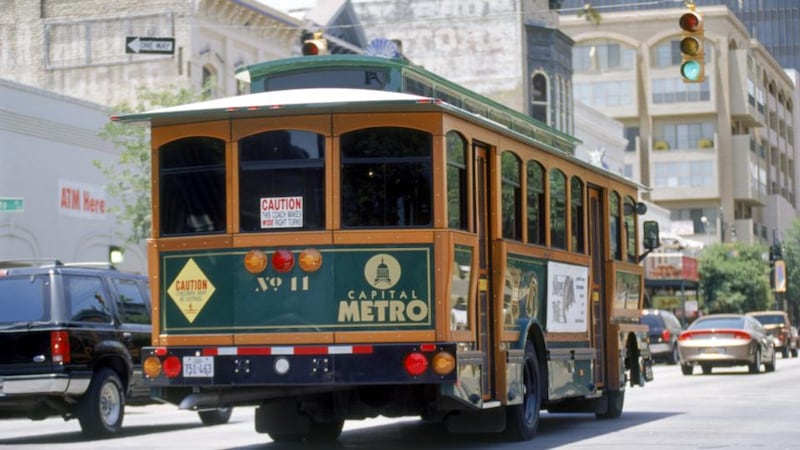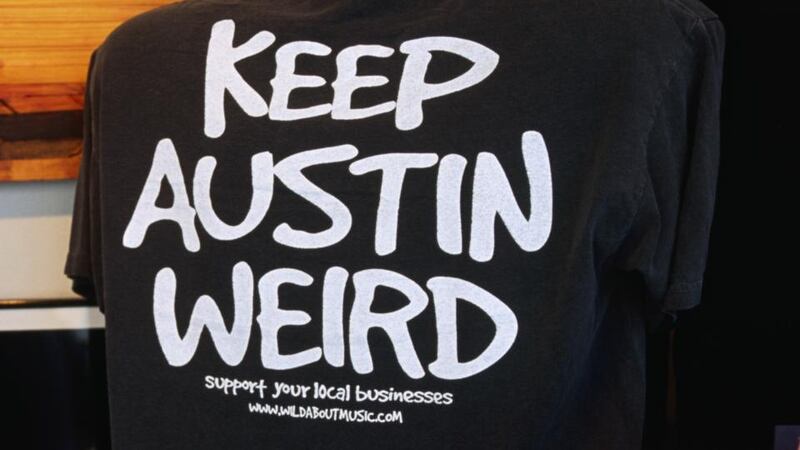Word of Austin’s allure is getting out. It’s now the fastest growing city in the US, consistently ranking as one of the safest and most highly educated metropolitan areas in the country. There are 300 days of sunshine a year, affordable rents in eclectic neighbourhoods, as well as more restaurants and nightclubs per capita than any other US destination.
All of this bolsters a fierce sense of independence that’s difficult to ignore. Merely mention the State it belongs to and people will pointedly tell you, “This isn’t Texas, it’s Austin”, while the city’s unofficial motto – “Keep Austin Weird” – is plastered across bumper stickers and T-shirts almost everywhere you look.
Though that slogan began as a campaign to support local businesses, it has since become a clarion call to protect the city's bohemian character. Where else would you find someone who has spent 25 years assembling a 60-ton monument in their backyard entitled The Cathedral of Junk? Where else would you find a mural that includes local resident Matthew McConaughey running naked through the streets with bongo drums?


Yet for a place that prides itself on a lack of chain stores, even at the airport, the price of increasing popularity is a sensitive issue. Some question whether Austin can cope with an average of 131 new arrivals per day, while others see the influx of tech companies such as Facebook, Apple and Google as a threat to its liberal ideology. But for the first-time visitor, Austin’s charms seem perfectly intact.
There are so many venues packed into its 298 square miles that the city bills itself not just as the alternative hub of Texas, but the live music capital of the world. Every March, more than 7,000 bands come to town for the industry showcase South by Southwest (SXSW), sleeping on floors and playing gigs anywhere they can set up instruments.
The likes of Willie Nelson and Stevie Ray Vaughan helped develop Austin’s music scene and today it encompasses 20 festivals, some of which are among the country’s finest. One of the most popular is Austin City Limits (ACL) – the festival offshoot of the 40-year-old television series – which runs for two consecutive weekends, featuring big-name line-ups in a relatively compact setting.
When I arrived at the most recent ACL, a long drought came to a dramatic end during a performance by The Cure, sending crowds fleeing from the site under thunder and lightning. Rain falls so seldom here that the ground struggles to cope with severe downpours. Eleven inches fell by morning, flooding the city and causing power cuts, meaning the rest of the festival had to be cancelled. Fortunately, there are plenty of other ways to enjoy Austin.
For starters, there’s the food. Franklin Barbecue is so renowned that queues begin outside long before it opens, at 11am, and food is only served until it runs out. Some locals, however, insist that other barbecue joints such as Stubb’s and Lambert’s are just as good, the latter noted for serving beef brisket rubbed with brown sugar and coffee. Vegetarians needn’t worry: Austin caters for non-meat eaters to a high standard, and it has been described as the most vegan-friendly city in the US.
Some of the best dishes in town have emerged from Austin’s food truck phenomenon. More than 1,600 have sprouted across the city, regularly changing locations, selling everything from gourmet crepes to ice-cream sandwiches, from pad Thai tacos to bacon-encrusted doughnuts.
Two of the more notable trailers include the Korean-Mexican fusion of Chi’lantro, famous for its caramelised kimchi fries, and the straight-talking Hey! . . . You Gonna Eat or What? where you can get a smoked-turkey-and-ham sandwich, fried in beer batter and served with cherry-fig jam. But perhaps the most novel food-truck is Way South Philly, where the staff (all of whom are ordained ministers) will gladly marry couples over a cheese-steak sandwich.
In terms of nightlife, tourists tend to clog up East Sixth Street (or ‘Dirty Sixth’) where, as one cab driver put it, “you’ll find class next door to trash” among its sports bars, late-running restaurants and clubs. But Austin’s most popular nightspots are now on Rainey Street, a residential road by the Colorado River that feels worlds away from downtown. This is the historic district, where the interiors of rundown homes from the 1930s have been converted into cosy lounge bars with wooden porches and backyards lit by fairy lights.
Craft Pride specialises in an extensive line of speciality beers served by knowledgeable staff, while Clive Bar’s creaking floors, vinyl seats and laid-back ambience is the ideal setting in which to enjoy a cocktail. Many of Rainey Street’s bars feature hammocks, hula-hoops and table tennis sets so you can make the most of Austin’s long, balmy nights – and locals will have you believe there’s little threat of mosquito bites thanks to a rather unusual presence.
Hanging under the South Congress Bridge is the largest urban bat colony in North America. Every March to November, onlookers gather at sunset to witness one of the most distinct sights in the city: 1.5 million bats streaming across the sky, ready to feed on more than 9,000kg of insects.
Following that same bridge south brings you to SoCo (South Congress Avenue), a shopping district known for its kitsch antiques and vintage clothing. The median age in Austin is around 30, so its eclectic array of boutiques reflects that demographic. This may be the only place where you’ll find Edwardian jewellery, customised cowboy boots and old soul records alongside each other. If you spot a classic car or two parked along the strip, you’ve probably found the historic Continental Club, a proudly preserved dive bar that’s hosted everyone from Kinky Friedman to Kris Kristofferson.
From here, you’ll also be able to see Austin’s State Capitol building looming in the distance at any time of day. This Renaissance Revival-style landmark is made from red granite, stands 15ft taller than its equivalent in Washington and is surrounded by 22 acres of landscaped lawns. It doesn’t cost anything to wander along the terrazzo floors, gawk up at the star-crowned rotunda and maybe even catch a glimpse of Texan politics at work.
But for a deeper sense of what’s behind the Lone Star identity, the nearby Bullock State History Museum chronicles its shared heritage over three floors of artefacts and multimedia exhibits, covering buffalo soldiers and Irish settlers right up to the State’s innovation in space travel.
Just one mile away is the University of Texas campus and its 100,000-seater sports stadium, home to the Texas Longhorns – one of the most successful programmes in American football. On game days, the atmosphere at tailgating parties outside the arena is a draw in itself: a pop-up village filled with canopies and deck chairs, swathed in orange (the team’s colours), where fans can bond over barbecue and beer.
For years, this was the biggest sports phenomenon in town. Now there’s a new contender: the Circuit of The Americas, the country’s first purpose-built Formula 1 track, which hosts the US Grand Prix, the X Games and MotoGP World Championships among others. Events of this scale help to bring in serious business – not just in ticket sales and corporate sponsorship – but in the 3,000 hotel rooms under construction downtown.
Sitting in the empty stands during a practice session, watching Ferraris race through the rain, I wondered whether this $400m race track infringed on Austin’s weirdness or typified it.
It had been a strange trip, full of colourful characters and curious encounters. I’d found a part of town that had been renamed Slackerville. I’d seen portraits of musicians rendered in fingernail art. I’d eaten things I didn’t think could be deep-fried: cheesecake, Oreos, even lemonade.
Were these the kind of things that made Austin a quirky oasis? Or were they the sort of stuff locals had come to roll their eyes at? It was hard to tell. But then maybe that’s just part of the experience. Maybe whatever changes Austin undergoes, it can at least be guaranteed to subvert expectations.
WHERE TO STAY
The W hotel: This centrally located, four-star hotel has nine types of room and an outdoor pool, but it's worth checking out just for the funky interior design, particularly the Record Room (featuring a wall-to-wall vinyl library) and the Secret Bar (a quiet cocktail lounge illuminated in red). whotelaustin.com
WHERE TO EAT
Moonshine Patio Bar & Grill: Brunch is a big deal in Austin and Moonshine's Sunday buffet is one of the most popular in town. The food is an inventive take on Southern classics – cornflake-crusted fried chicken, buttermilk biscuits and green chilli cheese grits. moonshinegrill.com
HOW TO GET THERE
American Airlines flies to Austin via Chicago, New York and London from €795 return. British Airways inaugurated a direct route from London Heathrow to Austin in March.
















